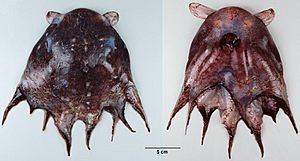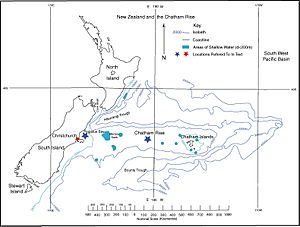Roughy umbrella octopus facts for kids
Quick facts for kids Roughy umbrella octopus |
|
|---|---|
 |
|
| Conservation status | |
| Scientific classification | |
| Genus: |
Opisthoteuthis
|
| Species: |
chathamensis
|
The Opisthoteuthis chathamensis is a special type of octopus often called the roughy umbrella octopus. It's a cirrate octopus, which means it has two fins on its head and a small, U-shaped shell inside its body. This unique octopus lives only near the seafloor around the Chatham Rise in New Zealand.
Contents
Meet the Roughy Umbrella Octopus
This amazing octopus is quite rare! It lives deep in the ocean, usually on soft, muddy bottoms. Scientists have found it at depths between 900 and 1,438 meters (about 2,950 to 4,700 feet). That's deeper than many tall buildings! The first time scientists officially found and described this octopus was near the Chatham Islands. This area is known as its "type locality."
Where Does This Octopus Live?
The roughy umbrella octopus has only been seen in one specific part of the world. It lives around the Chatham Rise, which is an underwater mountain range off the coast of New Zealand. It has also been found off the eastern coast of New Zealand's North Island. This octopus needs very specific conditions to survive, which is why it's only found in these deep, dark waters.
What Does It Look Like?
The roughy umbrella octopus can grow up to 18 centimeters (about 7 inches) long from the tip of its body to the end of its arms. Its main body, called the mantle, is about 5.4 centimeters (just over 2 inches) long.
Its arms are all about the same length. Males usually have 41 to 45 suckers on their arms, while females have a few more, typically 45 to 55 suckers. The underside of its body and the webbing between its tentacles are a deep maroon color. However, its suckers are a pale cream color, which makes them stand out!
Why Is This Octopus in Danger?
Sadly, the roughy umbrella octopus is in big trouble. It is listed as "Critically Endangered" by the IUCN (International Union for Conservation of Nature). This means there are very, very few of them left in the wild.
Scientists believe its population has dropped by about 70% in recent years. The last time it was commonly seen was in 1999. One reason for its decline is that it used to be caught by accident in fishing nets, a problem known as "bycatch."
This octopus also has a tough time recovering from population drops because of a few reasons:
- Long Lifespan: They live for a long time, which means they don't reproduce very quickly.
- Few Babies: They don't lay many eggs, so they have "low fecundity."
- Slow Growth: Their babies grow very slowly. For other similar octopus species, it can take 1.4 to 2.6 years for their eggs to hatch! This slow development makes it hard for their numbers to bounce back quickly.
Because of these challenges, the roughy umbrella octopus is very vulnerable and needs our help to survive.



